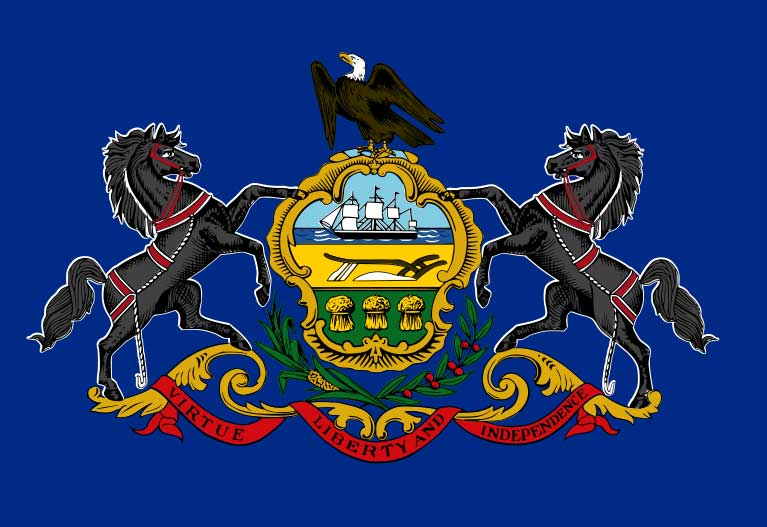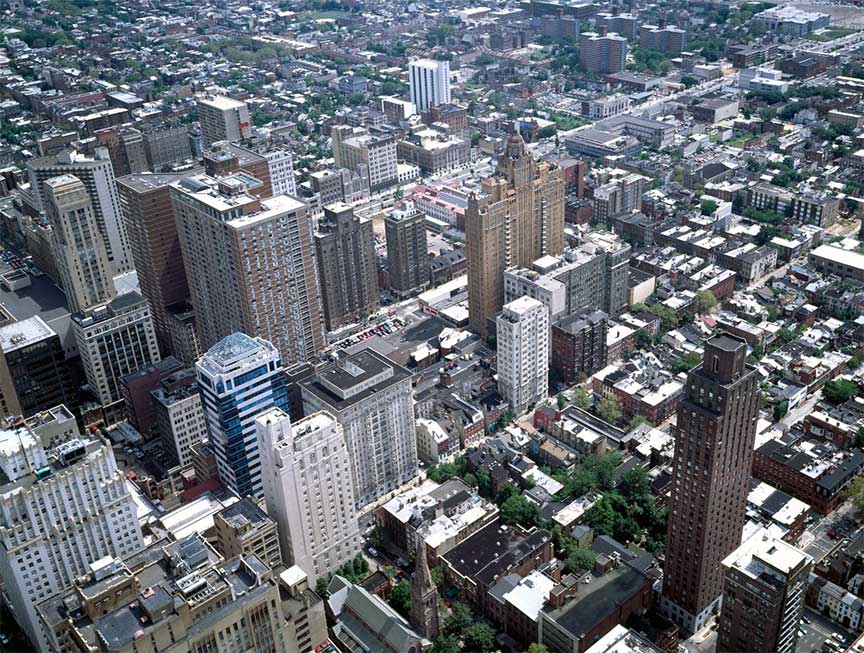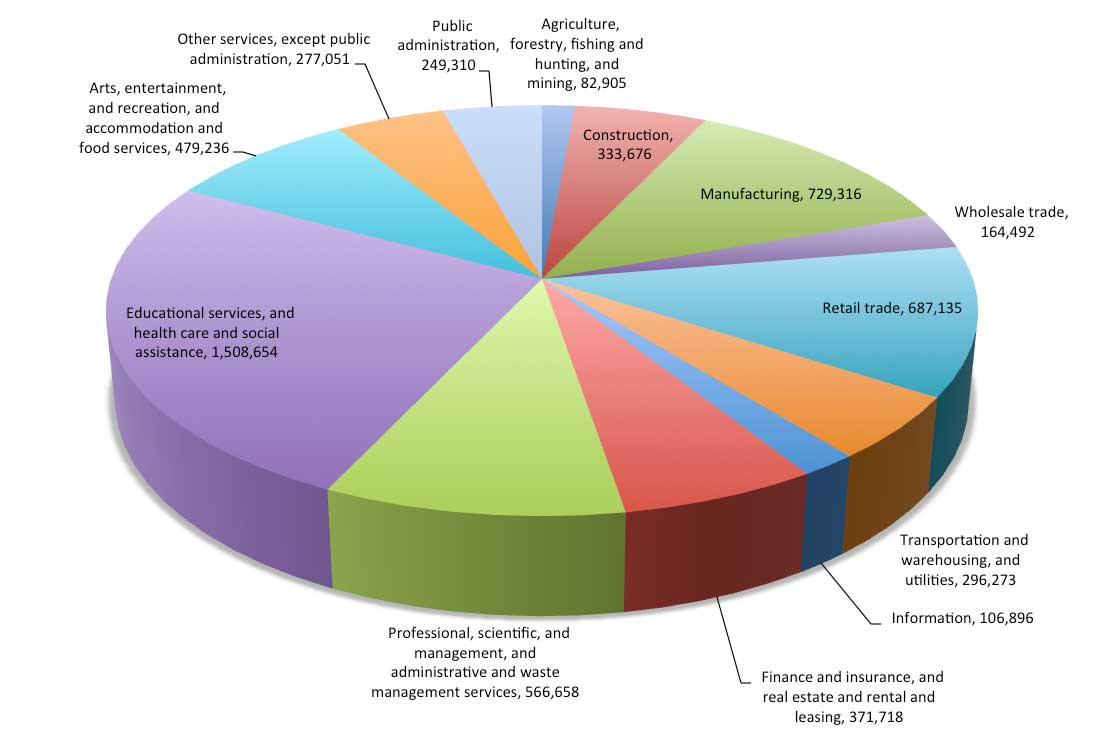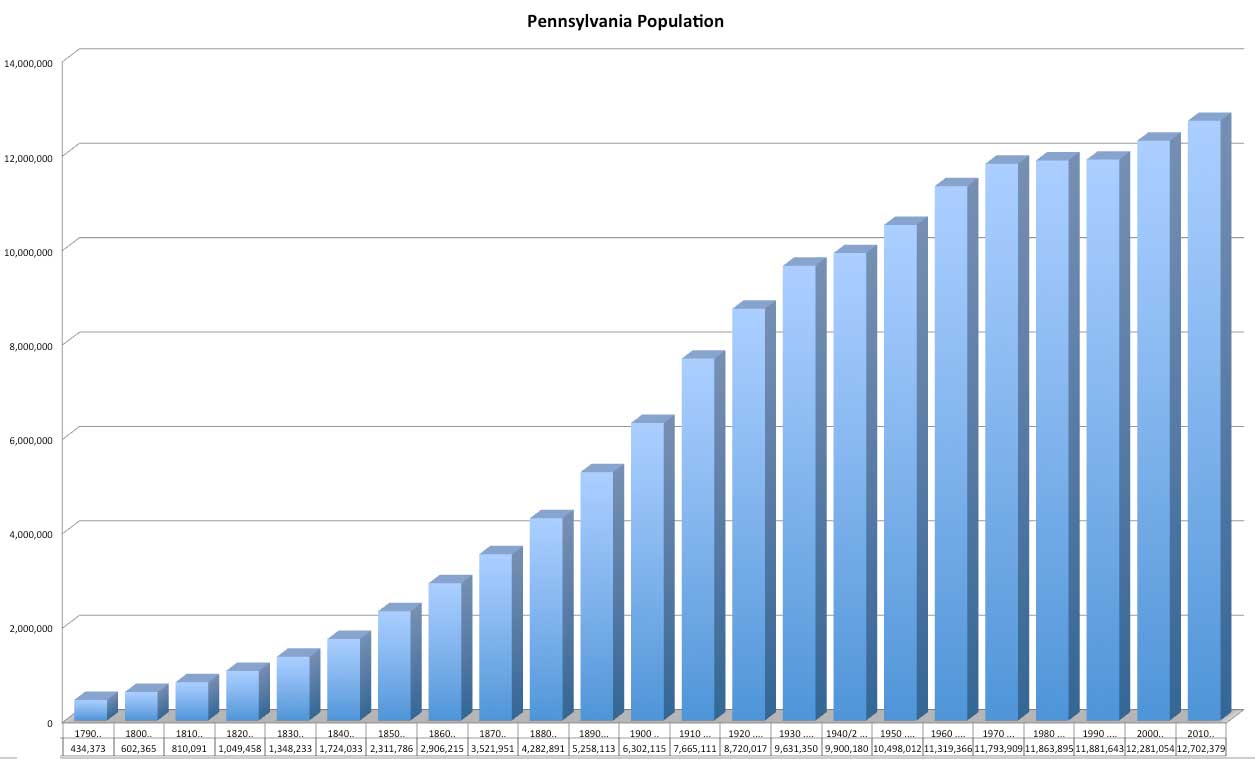Pennsylvania


Basic Information
Postal Abbreviation: PA
Natives: Pennsylvanian
Population 2020: 13,002,700
Legal Driving Age: 18
(17 w/ Driver's Ed.)
Age of Majority: 21
Median Age: 40.1
State Song: None
Median Household Income:$50,228
Mean Household Income:$67,298
Capital..... Harrisburg
Entered Union..... Dec. 12, 1787 (2nd)
Present Constitution Adopted: 1968
Nickname: Keystone State
Motto:
“Virtue, Liberty, and Independence”
Origin of Name:
Means “Penn's Woodland”. Named
after Adm. Sir William Penn, father
of William Penn.
USS Pennsylvania
Railroad Stations
Pennsylvania Economy
AGRICULTURE: cattle, corn, eggs,
hay, milk, mushrooms.
MINING: coal, limestone, natural gas,
petroleum, sand and gravel, stone.
MANUFACTURING: chemicals, clothing,
electrical equipment, food processing,
machinery, metal products, steel.
![]()

Pennsylvania Geography
Total Area: 45,759 sq. miles
Land area: 44,820 sq. miles
Water Area: 939 sq. miles
Geographic Center: Centre
2.5 mi. SW of Bellefonte
Highest Point: Mount Davis
(3,213 ft.)
Lowest Point: Delaware River
(sea level)
Highest Recorded Temp.: 111˚ F (7/10/1936)
Lowest Recorded Temp.: –42˚ F (1/5/1904)
Pennsylvania's physical characteristics divide into three parts: The southeastern section (from the Delaware River to the Blue Mountains) is a narrow level plain near the river, with rolling hill inland from the river. The mountain area, with broad mountains crosses the state form northeast to southwest. This range, which is part of the Appalachian, is 75 to 160 miles wide. The western part of the state slopes north and eastward toward New York and Lake Erie and the Ohio River.
Cities
Philadelphia, 1,526,006
Pittsburgh, 305,704
Allentown, 118,032
Erie , 101,786
Reading, 88,082
Scranton, 76,415
Bethlehem, 71,329
Lancaster, 56,348
Harrisburg, 48,950
Altoona, 49,523
Pennsylvania History
1681 William Penn, a Quaker is granted nearly all of Pennsylvania. The next
year he arrives and founds the colony.
1688 Quakers in Germantown came out against slavery.
1774 The first Continental Congress meets in Philadelphia.
1776 The members of the Second constitutional Congress issue the Declaration
of Independence.
1777 General Washington’s troops are defeated at the Battle of Brandywine
1777-78 The American Army is forced to camp at Valley Forge.
1787 The Constitutional Convention meets in Philadelphia.
1859 The first commercial oil well was drilled in Titusville.
1863 Battle of Gettysburg is fought. It is a decisive Union victory.
President Lincoln gives his Gettysburg address at the dedication of the
cemetery there.
1876 The US centennial exhibition is held in Philadelphia.
1889 When a dam fails Johnstown is destroyed.
1979 A major accident occurs at the Three mile nuclear plant.
Famous People
Daniel Boone
James Buchanan
Rachel Carson
Robert Fulton
Alexander Haig
Lee Iacocca
Reggie Jackson
George C. Marshall
George McClellan
Margaret Mead
Arnold Palmer
Robert E. Peary
James Stewart
Anthony Wayne

Pennsylvania National Sites
1) Allegheny Portage Railroad
The first railroad to circumvent the Allegheny Mountains, the Allegheny Portage Railroad was the finishing piece of the Pennsylvania Mainline Canal. "The Portage," opened in 1834, marking the first time that there was one, direct route between Philadelphia and Pittsburgh. All things to all people, it served merchants, passengers, slaves in pursuit of freedom, and soldiers from the Mexican War
2) Delaware & Lehigh
Come journey through five Pennsylvania counties bursting with heritage and brimming with outdoor adventure. You will find something for everyone. Follow a history trail marked with stories about hearty lumberjacks, coal miners, lock tenders, and railroaders. Explore quiet canal paths, challenging bike trails and the rippling waters of the Delaware and Lehigh Rivers.
3) Deshler-Morris House
Twice this house sheltered George Washington. In October 1793, he found refuge during the deadly Yellow Fever epidemic in Philadelphia. The following summer, it was a welcome retreat from the heat of the capital city.
4) Edgar Allan Poe National Historic Site
Described as horrifying, mystifying, and full of genius, Poe’s writing has engaged readers all over the globe. The six years Poe lived in Philadelphia were his happiest and most productive. Yet Poe also struggled with bad luck, personal demons and his wife’s tuberculosis. In Poe’s humble home, reflect on the human spirit surmounting crushing obstacles, and celebrate Poe’s astonishing creativity.
5) Eisenhower National Monument
This National Monument is located in Southwestern Oregon. The temperature in the cave is between 38 to 47 degrees and the walk through it is like climbing a 25 story building.
6) Flight 93
On Tuesday morning, September 11, 2001, the U.S. came under attack when four commercial airliners were hijacked and used to strike targets on the ground. Nearly 3,000 people tragically lost their lives. Because of the actions of the 40 passengers and crew aboard one of the planes, Flight 93, the attack on the U.S. Capitol was thwarted.
7) Fort Necessity National Battlefield
The battle at Fort Necessity in the summer of 1754 was the opening action of the French and Indian War. This war was a clash of British, French and American Indian cultures. It ended with the removal of French power from North America. The stage was set for the American Revolution.
8)Gettysburg National Military Park
The Battle of Gettysburg was a turning point in the Civil War, the Union victory that ended General Robert E. Lee's second and most ambitious invasion of the North. Often referred to as the "High Water Mark of the Rebellion", Gettysburg was the war's bloodiest battle with 51,000 casualties. It was also the inspiration for President Abraham Lincoln's immortal "Gettysburg Address".is like climbing a 25 story building.
9) Gloria Dei Church National Historic Site
Before Pennsylvania there was New Sweden. Discover this last historic link to a forgotten past. Visit the church's pastoral surroundings and its burial ground of patriots and ordinary citizens alike.
10) Hopewell Furnace National Historic Site
Hopewell Furnace showcases an early American industrial landscape from natural resource extraction to enlightened conservation. Operating from 1771-1883, Hopewell and other "iron plantations" laid the foundation for the transformation of the United States into an industrial giant. The park's 848 acres and historic structures illustrate the business, technology and lifestyle of our growing nation.
11)Independence National Historical Park
Independence Hall echoes these words. Nearby the old cracked Bell proclaims liberty. The spirit of Franklin is alive in his adopted city. Become part of America's journey in discovering its past.
12)Johnstown Flood National Memorial
The South Fork dam failed on Friday, May 31, 1889 and unleashed 20,000,000 tons of water that devastated Johnstown, PA. The flood killed 2,209 people but it brought the nation and the world together to aid the "Johnstown sufferers." The story of the Johnstown Flood reminds us all, "...that we must leave nothing undone for the preservation and protection of our brother men."
13) Steamtown National Historic Sit
Feel the heat from the firebox. Hear the bell and whistle. Smell the hot steam and oil. Feel the ground vibrate under your feet. See the one ton drive rods turn the wheels. Hear the chuff-chuff of the smokestack. Today, you can relive the era of steam as the engines come back to life. The cinders and grease, the oil and steam, the people and stories of railroading have returned.
14)Thaddeus Kosciuszko National Memorial
Visit the house where wounded Polish freedom fighter Thaddeus Kosciuszko lived and hear how this brilliant military engineer designed successful fortifications during the American Revolution. See the room where he received notable visitors such as Chief Little Turtle and Thomas Jefferson.
15)Valley Forge National Historical Park
Valley Forge was the site of the 1777-78 winter encampment of the Continental Army. The park commemorates the sacrifices and perseverance of the Revolutionary War generation and honors the ability of citizens to pull together and overcome adversity during extraordinary times.
 >
>